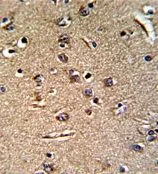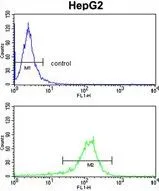
IHC-P analysis of human brain tissue using GTX81477 GGT5 antibody, N-term.
GGT5 antibody, N-term
GTX81477
ApplicationsFlow Cytometry, Western Blot, ImmunoHistoChemistry, ImmunoHistoChemistry Paraffin
Product group Antibodies
ReactivityHuman, Mouse
TargetGGT5
Overview
- SupplierGeneTex
- Product NameGGT5 antibody, N-term
- Delivery Days Customer9
- Application Supplier NoteWB: 1:1000. IHC-P: 1:50-1:100. FACS: 1:10-1:50. *Optimal dilutions/concentrations should be determined by the researcher.Not tested in other applications.
- ApplicationsFlow Cytometry, Western Blot, ImmunoHistoChemistry, ImmunoHistoChemistry Paraffin
- CertificationResearch Use Only
- ClonalityPolyclonal
- ConjugateUnconjugated
- Gene ID2687
- Target nameGGT5
- Target descriptiongamma-glutamyltransferase 5
- Target synonymsgamma-glutamyl cleaving enzyme; gamma-glutamyl transpeptidase-related enzyme; gamma-glutamyl transpeptidase-related protein; gamma-glutamyltransferase-like activity 1; gamma-glutamyltranspeptidase 5; GGL; GGT 5; GGTLA1; GGT-REL; glutathione hydrolase 5 proenzyme; leukotriene-C4 hydrolase
- HostRabbit
- IsotypeIgG
- Protein IDP36269
- Protein NameGlutathione hydrolase 5 proenzyme
- Scientific DescriptionThis gene is a member of the gamma-glutamyl transpeptidase gene family, and some reports indicate that it is capable of cleaving the gamma-glutamyl moiety of glutathione. The protein encoded by this gene is synthesized as a single, catalytically-inactive polypeptide, that is processed post-transcriptionally to form a heavy and light subunit, with the catalytic activity contained within the small subunit. The encoded enzyme is able to convert leukotriene C4 to leukotriene D4, but appears to have distinct substrate specificity compared to gamma-glutamyl transpeptidase. Alternative splicing results in multiple transcript variants encoding different isoforms. [provided by RefSeq, Oct 2014]
- ReactivityHuman, Mouse
- Storage Instruction-20°C or -80°C,2°C to 8°C
- UNSPSC12352203
References
- Leucyl-tRNA synthetase is a tumour suppressor in breast cancer and regulates codon-dependent translation dynamics. Passarelli MC et al., 2022 Mar, Nat Cell BiolRead more



